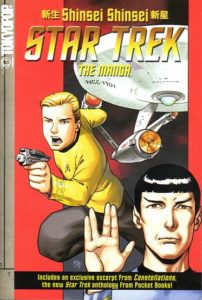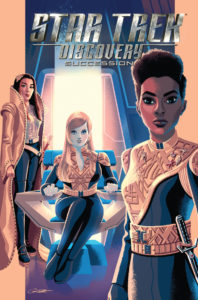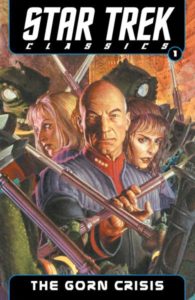Someday (God willing) I hope to explain to future generations the full scope of how the manga market blew the minds of western comics producers, and how quickly they tried to cash in on those sweet nerd bucks with only the most minor understanding of it. But any conversation on that would lead to one about how no comic publisher was so eager to cash in, writer/illustrator rights be damned, like Tokyopop. A name now synonymous in the comics world with the dreaded “paid in exposure.” Tokyopop while, from the looks of it was genuinely one of the publishers cornering the market on distributing manga titles for a US audience, really wanted to stake a claim in manga-style original works. They started publicizing an open submission policy. The results were….varied. Tokyopop famously struggled with establishing it’s market of original content, but that’s a whole other article. Like this one, this one, and these videos.
I have a very distinct memory of hanging out with high school friends at a Borders, thumbing through the still-recent manga section. There was something weirdly satisfying about seeing a selection of slice of life, romance, and girly space princess comics overshadowing the capes and tights section a lot of us had felt shunted out of. You’ve got to remember, these were the aughts. The big US-based comic publishers were still scratching their heads over this weird trend that they hadn’t known existed outside of Sailor Moon, and genuinely couldn’t figure out why they weren’t attracting that audience with their greased-up looking Emma Frost covers. And indie comics were very much darker, more cynical territory.
At the same time, looking through those hand-sized paperbacks was a crapshoot of its own. Original titles ranged from a young pre-Wet Moon Sophie Campbells foray into serial horror, to hyper stylized works of American art students fantasizing about how cool living in Japan must make you. One thing that kept popping up were attempts to adapt pre-existing properties into a Manga format. Which is how we get to the Star Trek Manga series based around TOS. Somewhere in the mix we found these books. And from our distinguished 10th grade palates our conclusion became “Why?” If you were going to try and tap into a younger audience why would you do it with the oldest series when we had all grown up with TNG, DS9, Voyager, even Enterprise? This was years before the reboot, and here they were trying to win us over with what was literally Your Dad’s Star Trek (in my defense, I was but a child). So back on the shelf it went. Probably in favor of something more sparkly and/or violent.
Star Trek The Manga: Shinsei Shinsei
 So with all this, you understand what was on my mind when I went into reading it. This weeks first book is Star Trek: The Manga title “Shinsei Shinsei,” an anthology by multiple writers and illustrators. And what I found was… equally varied. Each story in the volume had a different artist and writer team on board, which can work out really well in terms of an anthology series. In this case, as different stories sharing a volume there’s a definite unified vision missing, to the point where I’m not sure any prompt was given beyond mashing together the vague idea of Star Trek with the vague idea of manga. And when I say “vague” I mean VAAAAAAGUE.
So with all this, you understand what was on my mind when I went into reading it. This weeks first book is Star Trek: The Manga title “Shinsei Shinsei,” an anthology by multiple writers and illustrators. And what I found was… equally varied. Each story in the volume had a different artist and writer team on board, which can work out really well in terms of an anthology series. In this case, as different stories sharing a volume there’s a definite unified vision missing, to the point where I’m not sure any prompt was given beyond mashing together the vague idea of Star Trek with the vague idea of manga. And when I say “vague” I mean VAAAAAAGUE.
Not to get all champagne/sparkling wine nitpick here, but there’s a lot of needing to define what you can call manga vs. manga-inspired. Manga refers to comics falling into a specific style and genre coming out of the world of Asian, usually Japanese, comics and graphic novels. There are definitely stylistic choices made to emulate that, but they all look and feel really disingenuous. The Japanese title feels like a good example of this. The actual culture that spawned the style and medium of the work feels like set-dressing. There’s Japanese sound effects that make no sense for the western audience the book is marketed to other than to “look manga-y”. The writing definitely feels forced into the manga format. There’s huge chunks of text and bizarre pacing choices. A lot of the plots feel like they’re checking off of a list of “what’s the stuff in those books that the kids like?” There’s a sexy cyborg plot, a cute animal/monster plot. There’s even a traumatized kids piloting giant mechs plot (at which I had to text “Beam up to the Enterprise Shinji!” to as many people as possible).
I’m at a genuine loss for words on how to fully articulate how out of touch this book is with the zeitgeist it was trying to tap into. Each chapter makes usage of its comic format in ways that feel like clear references to what we think of as the manga genre, and while they sometimes come close to interesting, a lot of them lack the actual technical skill we look for in professional comic work. Making me wonder about that nasty habit Tokyopop was rumored to have of being banned from art school campuses after directly recruiting and screwing over their students. And there’s a timeliness to the specific manga-style being aped here that stood out to me. It felt less like they were trying to emulate the current style of manga that was being produced at the time and more like we were seeing emulations of the work in the 80’s and 90’s when manga first started getting attention from an American audience. The kind of works you see pop-up in those “comics every fan should read” lists. But not the stuff that we were considering the new and exciting stuff. Remembering my reasoning at Borders at the time, and after sharing some snapshots of the artwork with other friends who were part of the manga audience at the time, a general consensus formed: They were not only pitching us You Dad’s Star Trek, they were giving us Your Dad’s Manga.
To say nothing of the fact that a big part of the manga was the appeal of comics for an audience that wasn’t just middle-aged white dudes, and while this isn’t to say they Tokyopop wasn’t courting a wide audience that includes multiple demographics, this comic deeeefinitely doesn’t feel to appeal to it. So this book not only manages to overlook a major portion of the Star Trek fandom, it’s doing it while working in a medium heavily learning towards appealing to that very market. The only portion of the book that even passes the Bechdel-Wallace test is a chapter about a planet that fell to a gender-based war that contagiously breaks out on the Enterprise, which ends with the alien leaders of both sides destroying each other in a hissy-scratch fight. Yes, really.
The segment “Anything But Alone,” story by Joshua Ortega and art by Gregory Giovanni Johnson, was the part that hit the mark for me. The plot of a brilliant scientist alone on a planet with a version of his collapsed society rebuilt with microscopic machines, felt straight out of TOS. Johnson’s artwork felt like a respectable blend of the earlier Star Trek comics and the classic manga art style, like the kind referenced earlier but much more polished than most of the others.
Overall, the only major positive I can draw from this book is the kitsch factor. Like in 10 or 20 years, I feel like these are going to be something we can look back on and laugh at. But now, currently, It’s still too soon. It’s still too close to the point where I was the audience this was supposed to attract to not feel a level of “fuck-you” from the poor quality. A friend recommended that while I was looking for positive feedback that I look into their current work and see how they’ve progressed in their respective crafts. That’s where it ended up being even more depressing. Of the authors involved, as far as I can tell, all were all are white male writers who were already established in their field at the time of this books publication, and are still working in their fields. The same cannot be said on any front with the artists. Who, again as far as I could tell, were a more diverse bunch. Of the five featured in this book I could only find two that were still working in a professional capacity.
I rate it 10/90.
Star Trek Discovery: Succession
 Switching gears for book two this Week I opted to dip into some more recent work with Star Trek Discovery title “Succession” written by Kirsten Beyer and Mike Johnson with art by Angel Hernandez and colors by Mark Roberts. The story brings us back to the Mirror Universe after the events of Season 1 of Discovery, as the fallout of Emperor Georgiou’s “death” leaves the remaining power forces at war for control of the Terran Empire, while the report of Michael Burnham’s death prove to have been greatly exaggerated.
Switching gears for book two this Week I opted to dip into some more recent work with Star Trek Discovery title “Succession” written by Kirsten Beyer and Mike Johnson with art by Angel Hernandez and colors by Mark Roberts. The story brings us back to the Mirror Universe after the events of Season 1 of Discovery, as the fallout of Emperor Georgiou’s “death” leaves the remaining power forces at war for control of the Terran Empire, while the report of Michael Burnham’s death prove to have been greatly exaggerated.
It’s full of everything that you’d want standard in a Mirror Universe story: betrayal, wild outfits, incredible displays of cattiness (come to think of it, the Mirror Universe holds a lot of the same appeal as your standard primetime soap, which is good to know). Outside of all that, I was genuinely surprised with the range of the Discovery cast included. L’Rell and Amanda are revolutionary pals (what?) Harry Mudd is a good guy refugee on Risa (whaAaat?!) and Airiam finally gets her time to shine as the coldest of cold-blooded (Uuh-whaa?!?).
Hernandez’s sense of linework and shadow with Roberts color works in beautiful tandem. I found myself definitely appreciating the care that went into contrasting and complimenting the blue and yellow Terran uniform. And don’t think I didn’t see how popular that proud-boy haircut is in the empire Hernandez, I see it and appreciate you.
In contrast to the violent little romp that made up the rest of the book, the volume also contains a separate story centered around Pre-Discovery Stamets, the development of his work on the mycelial network, and the beginnings of his relationships with Culber and Tilly. Done with the same lineup, aside from colors by Esther Sanz, it’s very much a departure from the rest of the book. Enough that if it weren’t for the repeating creatives I’d be confused as to why they’re in the same book. But as it is, it makes for a pretty good show of range and with Sanz’s color it manages the shift.
Overall, a recommended read for everyone who didn’t think Prime Airiam got her due and/or any general Stamets fans. And definitely give a look-see to some of the included cover artists work.
I rate it 47/90.
Star Trek Classics Volume 1: The Gorn Crisis
 The final read for this review was Star Trek Classics Volume 1: The Gorn Crisis by Kevin J. Anderson and Rebecca Moesta with art by Igor Kordry. Crisis sees the Dominion War era Enterprise crew intervening during a Gorn uprising of their warrior caste to overthrow the ruling class.
The final read for this review was Star Trek Classics Volume 1: The Gorn Crisis by Kevin J. Anderson and Rebecca Moesta with art by Igor Kordry. Crisis sees the Dominion War era Enterprise crew intervening during a Gorn uprising of their warrior caste to overthrow the ruling class.
Now I want to say it was neat seeing something so quintessentially TOS being brought into a TNG setting. And it is cool to see that they’re still around, exist in a bigger context than fighting Kirk, and do in fact have a full society and culture that Starfleet is trying to engage with. But it was also a little tonally mish-mashed seeing the rubber suit aliens brought into the attempted seriousness of post TNG movie setting. Super brightly colored lizard men, while fun as hell, look a little weird in combination with those “we are very serious business” Starfleet uniforms. Kind of like seeing Don Draper wander on screen during an episode of Lost in Space. I wouldn’t count any of this as a slight against Kordry’s work though, it’s just a weird combination of aesthetics. And while reading the comic, I’d definitely recommend any digital readers go for full-page rather than panel by panel, both for the appreciation of Kordry’s sense of drama, and to spare yourself any “wow that guys eyes are far apart” nitpicking over appreciating the technical work that has gone into painting each page.
Riker is hanging out with Klingons, for some reason. And even though I found myself a few times asking “has he always been this ripped?” It was worth it for the payoff of watching a Gorn/Klingon showdown.
I appreciated the proactive roles that both Crusher and Troi got to have by being on the main away team, especially with Crusher getting to be “action doctor”… And Troi gets to be involved in preserving the line of the leadership. So, caste system protected…..yay? I guess? Would recommend it for any major Gorn fans.
I rate it 36/90.
Author’s note: Yes, I skimped on the “separate decades” rule this time. I’m currently working strictly with my libraries digital capability this round.